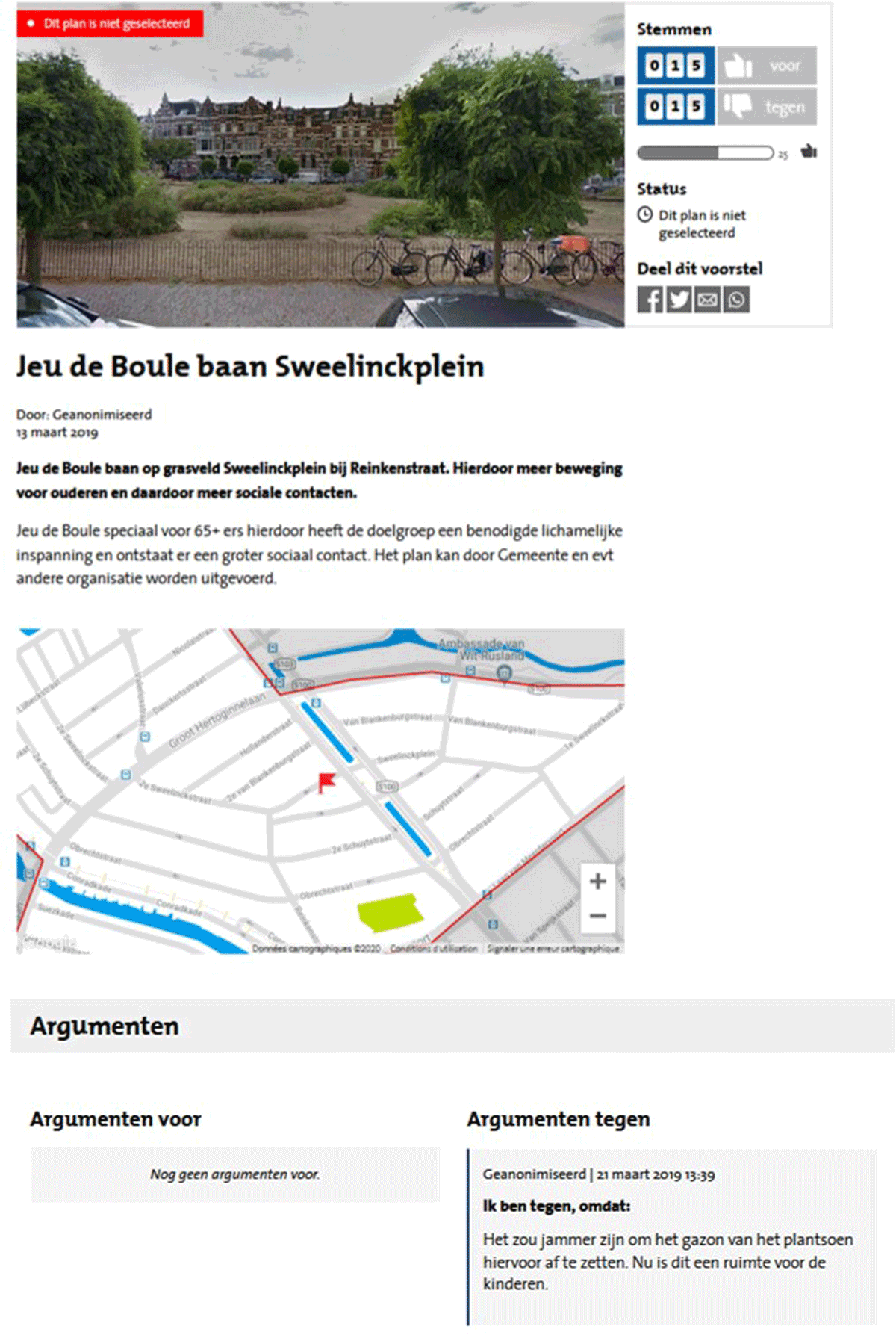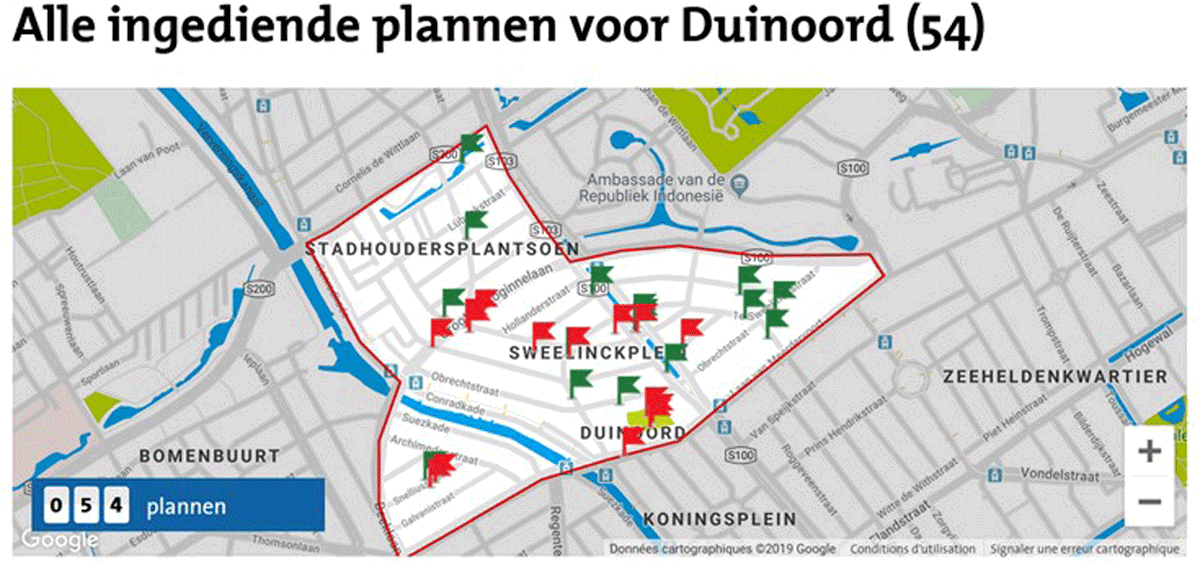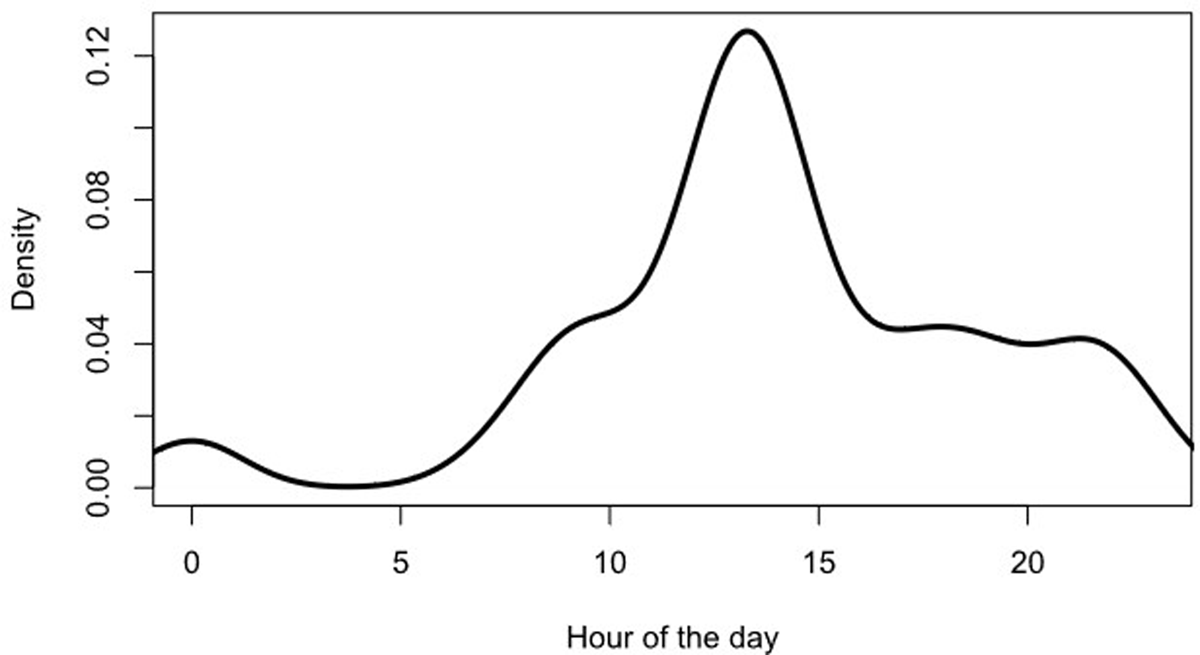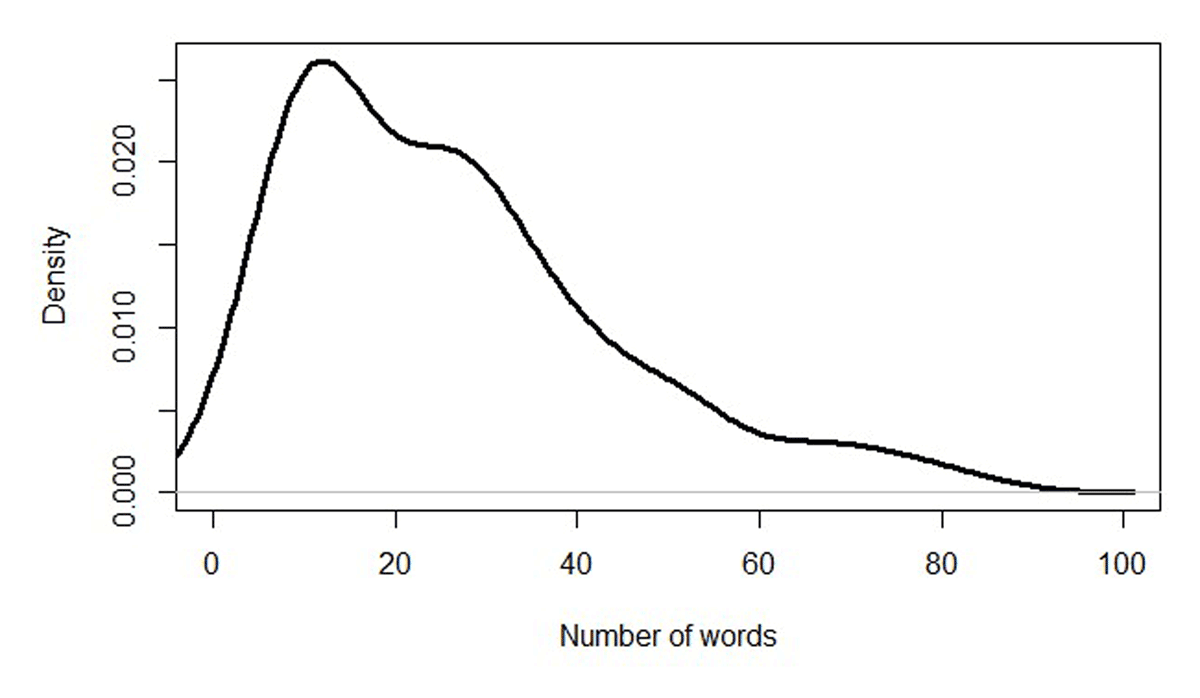Introduction
For over two decades now, governments have experimented with using the Internet to increase and deepen citizen involvement in policy-making. Hosting online citizen involvement can be appealing as it has the potential to reduce the costs of participation, attract a more diverse group of citizens, and facilitate ‘many-to-many communication’ (Albrecht 2006: 64). Yet, online participatory processes do not always live up to these promises. They sometimes simply reproduce offline participation patterns (Baek, Wojcieszak, & Delli Carpini 2012) or host discussions that do not reflect ‘intensive, empathetic, collaborative discourse’ (Hartz-Karp & Sullivan 2014: 2). The question therefore remains how governments can design online participatory processes that are inclusive and deliberative.
We examine this question based on our experiences with an online participatory budgeting (henceforth: ePB) process that took place in a neighborhood of The Hague, the Netherlands: Duinoord Begroot (https://www.duinoordbegroot.nl).1 Duinoord Begroot took place in 2019 after a series of experiments with so-called neighborhood budgets (wijkbudgetten) started by the municipality of The Hague in 2016. Neighborhood budgets allow citizens to submit proposals on how to improve the quality of life in their neighborhood and subsequently decide which of these projects receive part of a public budget for their implementation. Duinoord Begroot was the first neighborhood budget that was conducted online.
This case allows us to discuss the concrete choices involved in trying to design an online participatory process that is both inclusive and deliberative. We base our reflection on our own observations of the ePB process, semi-structured interviews with 11 neighborhood residents,2 a study on the usability of the online platform carried out by the municipality of The Hague among 5 citizens, and descriptive analyses regarding users’ activities on the online platform. We first describe the ePB process and evaluate it in terms of inclusivity and deliberation. We then compare it to other online participatory processes organized by governments elsewhere. We conclude with a discussion of the broader policy implications.
Online Participatory Budgeting in Duinoord
The main motivation to organize Duinoord Begroot online were low participation rates in preceding offline participatory processes. The online format was meant to reduce participation costs and thereby attract a larger and more diverse group of ‘all who are affected’ (Janssen & Kies 2005: 329) – that is, to be more inclusive. At the same time, the municipality wanted to not ‘merely [aggregate] the unreflective opinions of (…) voters’ (Hartz-Karp & Sullivan 2014: 2) but to also allow citizens to explain their (dis)approval of the proposals submitted via the platform in order for citizens and the municipality itself to better understand why people (do not) support the various proposals. In that sense, the municipality sought to stimulate deliberation, defined as a communicative process in which the involved citizens engage in a careful evaluation of both ‘arguments for and against a given proposition’ (Mercier & Landemore 2012: 246). In the following, we describe how the municipality tried to integrate these principles of inclusivity and deliberation in Duinoord Begroot.3
The ePB process allowed citizens to decide about the allocation of €30,000 to projects aiming to improve the quality of life in the neighborhood. It broadly consisted of five phases. At the start, the municipality invited citizens to submit their ideas to improve the quality of life in Duinoord via the online platform (March 1–April 7, 2019).4 Proposals could be submitted on three themes: (1) sports, play, and encounters; (2) streets; and (3) green areas and sustainability. This first phase was meant to be as inclusive as possible. Although the municipality made clear in a message before registration that it ‘especially invites people who live or work in Duinoord to vote and respond,’ anyone that registered on the platform could submit a project. Registration required an e-mail address, postal code, and first and last name.5
The municipality sought to enhance participation in several ways. First, a letter was sent out to all neighborhood residents in which the municipality explained the details of the ePB process and referred to the website. To raise awareness about the process, posters were distributed in the main shopping street of the neighborhood, newspaper articles and advertisements were published in local (and even a national) newspapers, and online videos and messages were posted on Facebook and Instagram. In addition, in an attempt to overcome a potential ‘digital divide’ (Janssen & Kies 2005), the municipality organized a meeting together with the neighborhood council6 and offered the possibility to submit a proposal ‘offline’ on Mondays, Wednesdays, and Fridays between 9:30 a.m. and 12:30 p.m. An additional slot was made available on one evening (7:00 p.m.–8:00 p.m.).
During this initial stage, registered users of the platform could engage in four other types of activities on the online platform: (1) they could post arguments in favor of and against a proposal; (2) respond to those arguments; (3) indicate their support for an argument by clicking on a ‘support’ (mee eens) button; and (4) like and dislike proposals. Figure 1 provides an example of a proposal that received 15 likes and 15 dislikes. One argument against the proposal was posted and none in favor of it.7 The arguments remained uncensored and no other type of (active) moderation was used. Nevertheless, the design of the platform sought to provide four types of ‘nudges’ towards deliberation (John, Smith, & Stoker 2009).
Example of an online proposal (archived version).
Source: Retrieved from https://www.duinoordbegroot.nl/archief.
First, the website juxtaposed arguments in favor of and against the proposal, with arguments favoring the proposal always appearing in a column on the left and arguments against it in a column on the right (Figure 1). This prevented arguments on either side to be pushed down the page, making sure that arguments posted on both sides would appear right underneath the proposal (cf. Zhang, Xi, & Chen 2019). Second, when users wanted to post a comment they were nudged towards giving an argument by the default introductory sentence ‘I am in favor of/against [the proposal] because…’ Third, the posts needed to include a minimum number of 40 characters in order to stimulate users to post substantive messages. Finally, each argument could be responded to by pressing a button ‘react’ (reageren) that pasted the response right underneath the argument, which could be considered as a way to enhance the reciprocity of the online conversation.
The ‘likes’ served to provide an initial indication of the amount of support for a proposal. A proposal needed a minimum of 25 likes to be eligible to go to the second stage of the process. This second stage consisted of a feasibility check carried out by civil servants of various departments of the municipality (April 8–May 13, 2019). On the one hand, they judged to what degree the proposal was in line with the ePB criteria (i.e. maximum costs of €30,000, meant to improve the quality of life in the neighborhood, executable within 12 months) and municipal policies and regulations. On the other hand, they assessed whether the proposal would be manageable by the respective municipal department. A summary of the conclusions was then posted on the online platform8 and the estimated costs were attached to those proposals that passed the feasibility check (21 out of 54 proposals).9
The third phase of the process (May 13–June 10, 2019) started with a second letter sent to all households in the neighborhood. It included a unique code that enabled residents aged 18 years and older to vote online for the 21 feasible proposals. Note, then, that during this voting stage the pool of participants was narrowed down to those affected, excluding non-residents from the process. Voting consisted of distributing the €30,000 over any number of projects, as long as the total amount was at least €25,000 and did not exceed €30,000. In the fourth phase (June 15, 2019), four winning projects were announced that gained most of the votes and, taken together, did not exceed the available amount of €30,000. The results were presented both on the online platform and at an award ceremony in a neighborhood park. In the ongoing final stage (June 16, 2019–June 15, 2020), the proposers of the winning projects are further developing their ideas with the help of civil servants and need to execute the projects before mid-June 2020.
Duinoord Begroot: Inclusivity
In total, 1,206 people registered on the ePB platform. Fifty-four proposals were submitted which, in total, received 1,852 likes and 448 dislikes. There were 64 unique users that posted at least one argument or response to an argument. During the final stage, 1,453 out of the total of 6,066 residents of 18 years or older cast their votes, amounting to 24% of the respective population.
The process also attracted a diverse range of proposals and participants. Figure 2 shows that the submitted proposals dealt with different areas of the neighborhood. Similarly, most of the interviewed participants agreed that the proposals also substantively reflected the diversity of issues in the neighborhood – at least those issues they thought could reasonably be addressed within the ePB framework.
Distribution of proposals across the neighborhood.
Note/source: Red/green flags: proposal not selected/selected for the final voting stage. Retrieved from https://www.duinoordbegroot.nl.
While we do not have background data on the proposers of the projects, indirect evidence points towards high diversity among this group of citizens. First, a member of the neighborhood council indicated that the participants included many people they had not heard about before. The ePB process therefore appears to have broadened the usual pool of participants that tends to be present at neighborhood council meetings. Some interviewees indicated in this respect that they saw Duinoord Begroot as a less costly way to participate compared to regular neighborhood meetings. Others expressed that it provided an opportunity to propose their own project rather than one that would have had to pass through something like a neighborhood council.
As another indication of the diversity of participants, the interviews showed that some proposers had lived in the neighborhood for years whereas others had just moved in. In fact, some proposals had been submitted by citizens not living in the neighborhood. The municipality also received three proposals on paper, providing some evidence that also residents lacking the requisite digital skills were able to submit their ideas. To illustrate, an 83-year old man submitted a project offline that a civil servant then put online. The project’s online reach was extensive, with 43 likes and 1 dislike as well as 273 votes in the final stage of the process.
Finally, online participation was taking place at different times of the day. Figure 3 shows the distribution of the number of comments (i.e. arguments and responses) by hour of day. The asynchronous nature of the process seems to have allowed citizens to participate with varying daily schedules (e.g. because of their employment status or working hours).
Duinoord Begroot: Deliberation
The 64 users that posted a comment on the online platform only constituted a small portion of the registered users (5.3%). Twelve of these users posted more than two comments and accounted for 88 of the total of 149 comments (59%). In fact, the top two users can be considered ‘superposters’ (Graham & Wright 2014), together accounting for 27.5% of all comments (41 out of 149) and 21.4% of all words devoted to the comments (849 out of 3,959).
Only 11% of all comments were explicitly posted as responses to arguments, making use of the ‘react’ button. This provides a rough indication that participants do not seem to have engaged much with each other’s arguments, at least within the bounds of the online platform. Moreover, a usability study conducted by the municipality suggests that the nudge to provide an argument (‘I am in favor of/against [the proposal] because…’) may have obstructed some participants from asking questions (van Boxtel & Broekhof 2019) – another key form of discursive engagement (Stromer-Galley 2007). In fact, one interviewee indicated that she missed the opportunity to explain her proposal to other residents in a face-to-face meeting, which would have allowed her to answer questions and gain feedback on her proposal. The current format did not allow for this according to her: ‘There were comments (…) [b]ut that’s a comment, not a question, you know. That’s different from “How does this actually work?”’
The ePB process does seem to have resulted in a relatively equal balance of arguments in favor of (73) and against the proposals (59). This is also reflected in the total number of words users devoted to each side (favoring: 1,884 words; against: 1,606 words).10 This suggests that the ePB process succeeded in gathering a substantial amount of arguments both in favor of and against the various proposals – something that residents could have potentially drawn on before casting their votes. However, most interviewees indicated that what they based their vote on was first and foremost the proposal, with the arguments according to the interviewees generally carrying little weight for their eventual choices. At the same time, users did frequently use the ‘support’ button, with a large majority of the arguments (70.5%) receiving at least one click on the support button and almost half (43.2%) two or more. This suggests that users did at least pay some attention to the arguments, although the total number of support clicks remained low (246 in total).
Finally, whereas we did not notice any offensive messages on the platform, not all arguments contained sophisticated reasons to support the claims they advanced. The length of the arguments provides a rough indication of this. Figure 4 shows the distribution of argument length, ranging from arguments of 4 to arguments of 84 words. As an illustration of the two extremes, consider two arguments both posted in favor of a proposal to plant bushes on the banks of canals to attract more insects and birds. Whereas one participant simply expressed support for the proposal (‘More flowers and green: DO IT!’), another participant justified the planting of bushes by linking it to increased biodiversity (‘More vegetation is good, especially insects that are increasingly having a tough time in the Netherlands. Recovery of razed banks and planting of more “insect-friendly” bushes on public plots of land are an efficient method to counteract the loss of biodiversity’).
Duinoord Begroot Compared
How does Duinoord Begroot compare to other online participatory processes? First, Duinoord Begroot garnered a high number of proposals and votes. While the number of registered users seems in line with figures reported for other local online platforms (Dunne, 2010), the voting rate of 24% of residents aged 18 or older appears comparatively high. Coleman and Sampaio (2017) show, for instance, that approximately 10% of registered voters cast their vote during the ePB process that took place in Belo Horizonte in 2006.11 The authors attribute decreasing voting rates in subsequent years partly to stricter registration requirements. The reverse might explain the relatively high voting rate in Duinoord: the municipality facilitated voting by (1) mailing the unique voting code to every household and (2) refraining from setting excessive registration requirements. This explanation is in line with classic resource and mobilization models of political participation (e.g. Leighley, 1995): citizens are more likely to participate when (1) they are asked to do so and (2) participation is cheap.
Duinoord Begroot also gathered a relatively high number of proposals. To illustrate, Schneider and Busse (2019) report that an ePB process in the German city of Oldenburg gathered 144 proposals. Another ePB process in Frankfurt gathered 1,328 proposals. As these processes took place in urban areas 25–110 times more populous than Duinoord, the number of submitted proposals during Duinoord Begroot (54) seems high. This may be related to the expected policy impact of the process (Fung 2006). Whereas participants in the aforementioned German cities were skeptical about the impact PB might have, Duinoord Begroot seems to have signaled a clear commitment to the execution of submitted proposals, including it explicitly in the description and planning of the process on the website. Some skepticism notwithstanding, several of our interviewees that had submitted a proposal indeed saw it as a way to put their stamp on neighborhood policy. In addition, our findings suggest that the openness of the submission stage also contributed to the high number of proposals, allowing also citizens from outside of Duinoord to upload a proposal.
Turning to the online discussions, the process stimulated little activity on the online platform. Very few residents contributed to the discussions, equaling around 1% of the neighborhood population and posting 149 comments. Nonetheless, this closely matches figures reported for other online government platforms. To illustrate, Jensen (2003) shows for a local online government platform preceding regional elections in Denmark in 2001 that 74 citizens contributed 150 posts over the course of two and a half months. Similarly, the Oldenburg ePB process referred to above attracted an average of 2.4 comments per proposal (Schneider & Busse 2019). The relative number of comments appearing on online government platforms taking place in more populous areas also appears similar (e.g. Albrecht 2006 [Hamburg]; Barros & Sampaio 2016 [Belo Horizonte]; Wright 2006 [United Kingdom]).12
The ‘discursive concentration’ (Kies 2010) we observed seems common too. Albrecht (2006) notes that the 20% most active posters on the DEMOS platform in Hamburg in 2001 accounted for more than 75% of all comments. In Duinoord, the top 20% accounted for 60.4% of all comments. The number of so-called superposters seems to have been rather high, however. Whereas the most active poster in the DEMOS debate contributed 4.3% of all comments, the most active poster on Duinoord Begroot contributed 18.8%. Similarly, Wright (2006: 557) reports for the nationwide platform Downing Street in the United Kingdom that ‘[t]he top 10 posters to the discussions made 9.32 per cent of the posts.’ By contrast, the top ten posters in Duinoord contributed 55% of all comments. Still, this appears to be the result of the lower number of total comments in Duinoord, making it easier for a single participant to contribute a high share of comments. For example, contributing 55% of all comments in the case of DEMOS would have amounted to 2,149 comments; in the case of Downing Street, this would have been 60,642 comments(!) (own calculations).
Finally, we underline the remarkably equal balance of arguments in favor of and against the submitted proposals. To put this into perspective we return to the example of Belo Horizonte where the ePB discussions, in practice, also remained largely unmoderated but lacked the nudges used on the Duinoord Begroot platform. The discussions only generated a limited number of comments against the submitted projects (10.7 to 27.6% of all comments) (Barros & Sampaio 2016). This comparison, hence, gives a preliminary indication that specific design choices can nudge citizens to not only post arguments in favor of but also against the proposals. In addition, the absence of moderation also did not lead to offensive language usage, challenging the claim that ‘censoring the content of online discussion is necessary if debates are not to be fractured by rude language’ (Wright 2006: 558 [emphasis added]).
Conclusion: Policy Lessons
A key challenge for governments in an era of ‘communicative plenty’ is to create spaces for deliberation (Ercan, Hendriks, & Dryzek 2019). Ideally, they manage – in one way or another – to involve all those affected in a thorough and respectful conversation about public policy. Duinoord Begroot sought to involve more people in direct decision-making and to create an online space for gathering ideas and exchanging arguments in order to improve the quality of life in the neighborhood. As we have shown, the challenges we were confronted with in Duinoord are common for online participatory processes in general. Below, we point out three policy lessons drawn from this experience that we consider relevant for other practitioners interested in promoting inclusivity and deliberation via online platforms.
Lesson 1: Participation Needs to Be Personal, Open, and Cheap. Our observations suggest that high voting rates can be achieved by personally inviting residents to participate and by restricting voting requirements to the bare minimum. Similarly, Duinoord Begroot managed to gather so many proposals in part by relaxing participation criteria in the first stage of the process, opening up the process even to non-residents.
Lesson 2: Incentives Are Crucial for Citizens to Contribute to Online Discussions. The ePB platform lacked a clear incentive to contribute to the online discussions. To illustrate, the ‘support button’ format used for Duinoord Begroot did not provide the poster receiving the ‘support clicks’ with a clear incentive to post more in the future (cf. Barros & Sampaio 2016: 298). A key recommendation, therefore, is to link the posting of an argument or response to clear gains that can be expected in return (e.g. a particular online social status or points to be used later in the ePB process) (Gastil & Richards 2017). Additionally, the findings suggest that a simple option to post a question to the proposer could already stimulate further discursive engagement online. Finally, proposals could now only be revised as long as there were no comments posted in response to the proposal. This made it impossible to integrate comments into the proposal and signal to users that their comments were taken into consideration and made a difference. Allowing for a feedback loop between the comments and the proposals could remedy this.
Lesson 3: Citizens Can Be Nudged towards Online Deliberation. This case of ePB suggests that nudging can be an effective alternative to the (active) moderation of online discussions to stimulate deliberation. Certainly, neither nudging nor moderation is ideal: moderation may signal a lack of popular control over the process or even lead to ‘accusations of political censorship’ (Wright 2006); nudging citizens towards deliberation may not always be enough to prevent the posting of offensive comments. We therefore simply want to stress that there are many more design options to steer people towards deliberation than moderation alone. These merit attention in future research and practice.
Notes
- A loose translation of the name is ‘Duinoord engages in budgeting,’ with Duinoord referring to the respective neighborhood in The Hague. ⮭
- The first author conducted the interviews in September 2019. The interviews were held with citizens that had been involved in the process in varying ways: some had only voted during the final stage of the process, while others had also submitted a proposal and/or posted comments on the ePB platform. The interviewees were between 25 and 76 years old (7 male, 4 female). Ethical approval for conducting the interviews was obtained from the Comité d’éthique ISPOLE at Université catholique de Louvain. ⮭
- The open source software used for Duinoord Begroot was initially developed by the municipality of Amsterdam. For more information see: https://www.amsterdam.nl/bestuur-organisatie/meedenken-meepraten/openstad-online. ⮭
- Proposals could be submitted between March 1 and March 31, 2019. Commenting on proposals and (dis)liking them could be done until April 7, 2019. ⮭
- This was also required for posting comments. An additional requirement for submitting a proposal was an initial estimation of the costs of the proposed project (only visible to the municipality). ⮭
- The neighborhood council is formally a non-profit organization that seeks to promote the interests of neighborhood residents. For more information see: https://www.duinoord-denhaag.nl/node/5. ⮭
- The argument against the proposal in this example received one ‘support click.’ This was displayed underneath the comment as ‘Mee eens (1)’ (i.e. ‘Agree (1)’). This version retrieved from the Duinoord Begroot online archive did not display this anymore. ⮭
- Note that the municipality published these conclusions for all proposals (i.e. also for those that did not pass the feasibility check). ⮭
- The costs were jointly estimated by the municipality and the respective resident(s) that had submitted the proposal. ⮭
- Six proposals received no comments at all (11%), fifteen proposals (28%) did not receive any arguments in support, and sixteen proposals (30%) received no arguments against. ⮭
- Note that voting rates in offline PB editions in Belo Horizonte were much lower in the first two editions. Furthermore, Internet access increased over the years, while online participation dropped (Barros & Sampaio 2016). This suggests that the lack of participation was not simply due to a lack of Internet access. Voting rates also appear lower in PB processes in Western contexts. For example, the PB processes with online voting opportunities in Chicago’s 35th (2017) and 36th (2018) wards show even lower voting rates than in Belo Horizonte, see http://www.pbchicago.org. ⮭
- Percentage of comments per registered voter: Duinoord, Duinoord Begroot: 2.46%; Belo Horizonte, ePB: 0.07% (2008), 0.06% (2011); United Kingdom, Downing Street (2000): 0.25%; Hamburg, DEMOS (2002): 0.32%. Own calculations based on number of registered voters retrieved from Barros and Sampaio (2016: 297) (Belo Horizonte: 2008, 2011); https://www.ons.gov.uk/peoplepopulationandcommunity/elections/electoralregistration/datasets/ electoralstatisticsforuk (United Kingdom: 2000); and https://www.statistik-nord.de/wahlen/wahlen-in-hamburg/buergerschaftswahlen/2001/ (Hamburg: 2001). ⮭
Acknowledgements
The authors would like to thank the two anonymous reviewers for their valuable comments and Jasper Hooghwinkel for his research assistance.
Competing Interests
David Bos works as a policy advisor on citizen participation for the Municipality of The Hague and was involved in the design and execution of Duinoord Begroot.
Funding Information
Ramon van der Does received support from the Fonds spéciaux pour la recherche - Université catholique de Louvain (ADi/DB/10256.2018) and from the F.R.S.-FNRS (FC27855).
References
1 Albrecht, S. (2006). Whose voice is heard in online deliberation? A study of participation and representation in political debates on the internet. Information, Community and Society, 9(1), 62–82. DOI: http://doi.org/10.1080/13691180500519548
2 Baek, Y. M., Wojcieszak, M., & Delli Carpini, M. X. (2012). Online versus face-to-face deliberation: Who? Why? What? With what effects? New Media & Society, 14(3), 363–383. DOI: http://doi.org/10.1177/1461444811413191
3 Barros, S. A., & Sampaio, R. C. (2016). Do citizens trust electronic participatory budgeting? Public expression in online forums as an evaluation method in Belo Horizonte. Policy & Internet, 8(3), 292–312. DOI: http://doi.org/10.1002/poi3.125
4 Coleman, S., & Sampaio, R. C. (2017). Sustaining a democratic innovation: A study of three e-participatory budgets in Belo Horizonte. Information, Communication & Society, 20(5), 754–769. DOI: http://doi.org/10.1080/1369118X.2016.1203971
5 Dunne, K. (2010). Can online forums address political disengagement for local government? Journal of Information Technology & Politics, 7(4), 300–317. DOI: http://doi.org/10.1080/19331681.2010.491023
6 Ercan, S. A., Hendriks, C. M., & Dryzek, J. S. (2019). Public deliberation in an era of communicative plenty. Policy & Politics, 47(1), 19–36. DOI: http://doi.org/10.1332/030557318X15200933925405
7 Fung, A. (2006). Varieties of participation in complex governance. Public Administration Review, 66(s1), 66–75. DOI: http://doi.org/10.1111/j.1540-6210.2006.00667.x
8 Gastil, J., & Richards, R. C. (2017). Embracing digital democracy: A call for building an online civic commons. PS: Political Science & Politics, 50(3), 758–763. DOI: http://doi.org/10.1017/S1049096517000555
9 Graham, T., & Wright, S. (2014). Discursive equality and everyday talk online: The impact of ‘superparticipants’. Journal of Computer-Mediated Communication, 19(3), 625–642. DOI: http://doi.org/10.1111/jcc4.12016
10 Hartz-Karp, J., & Sullivan, B. (2014). The unfulfilled promise of online deliberation. Journal of Public Deliberation, 10(1), 1–5. DOI: http://doi.org/10.16997/jdd.191
11 Janssen, D., & Kies, R. (2005). Online forums and deliberative democracy. Acta Politica, 40(3), 317–335. DOI: http://doi.org/10.1057/palgrave.ap.5500115
12 Jensen, J. L. (2003). Public spheres on the internet: Anarchic or government-sponsored – A comparison. Scandinavian Political Studies, 26(4), 349–374. DOI: http://doi.org/10.1111/j.1467-9477.2003.00093.x
13 John, P., Smith, G., & Stoker, G. (2009). Nudge nudge, think think: Two strategies for changing civic behaviour. The Political Quarterly, 80(3), 361–370. DOI: http://doi.org/10.1111/j.1467-923X.2009.02001.x
14 Kies, R. (2010). Promises and limits of web-deliberation. New York: Palgrave Macmillan. DOI: http://doi.org/10.1057/9780230106376
15 Leighley, J. E. (1995). Attitudes, opportunities and incentives: A field essay on political participation. Political Research Quarterly, 48(1), 181–209. DOI: http://doi.org/10.1177/106591299504800111
16 Mercier, H., & Landemore, H. (2012). Reasoning is for arguing: Understanding the successes and failures of deliberation. Political Psychology, 33(2), 243–258. DOI: http://doi.org/10.1111/j.1467-9221.2012.00873.x
17 Schneider, S. H., & Busse, S. (2019). Participatory budgeting in Germany: A review of empirical findings. International Journal of Public Administration, 42(3), 259–273. DOI: http://doi.org/10.1080/01900692.2018.1426601
18 Stromer-Galley, J. (2007). Measuring deliberation’s content: A coding scheme. Journal of Public Deliberation, 3(1). DOI: http://doi.org/10.16997/jdd.50
19 van Boxtel, P., & Broekhof, B. (2019). Rapportage Stadskamer: DPZ – Duinoord Begroot fase 1. The Hague: Municipality of The Hague.
20 Wright, S. (2006). Government-run online discussion fora: Moderation, censorship and the shadow of Control 1. The British Journal of Politics & International Relations, 8(4), 550–568. DOI: http://doi.org/10.1111/j.1467-856x.2006.00247.x
21 Zhang, W., Xi, Y., & Chen, A. (2019). Why do replies appear? A multi-level event history analysis of online policy discussions. New Media & Society, 22(8). DOI: http://doi.org/10.1177/1461444819880520





